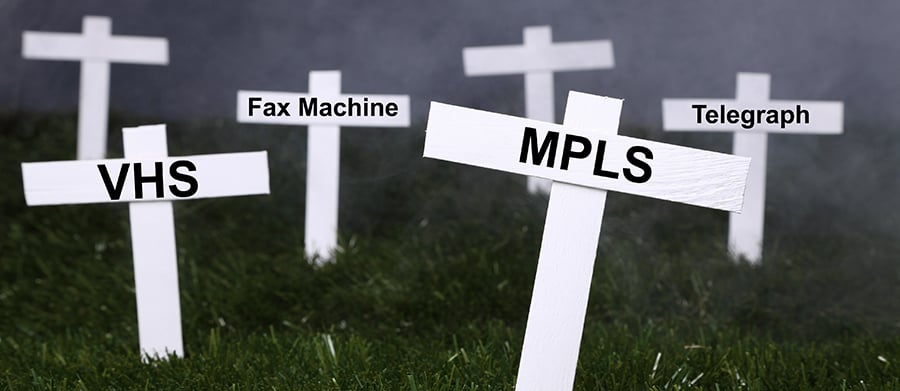The Slow Death of MPLS

Sometimes, I feel sad for technologies. When they first emerge they are exciting, new, and innovative. But eventually every technology, no matter what problem it was initially created to solve, will be surpassed by something better. Such is the case with Multiprotocol Label Switching (MPLS).
The Once-Gold Standard in Secure WAN
MPLS was invented and standardized by the Internet routing community, driven by equipment suppliers like router vendors who wanted a better way to deliver Quality of Service (Qos) using IP-based technologies. By introducing MPLS, service providers and enterprises were able to build secure, “fast lanes” for applications transferring data, rather than requiring more intensive network routing.
This technology was useful and enjoyed wide adoption. MPLS became the gold standard for high-quality managed wide area networks (WAN). The equipment suppliers sold the routers to enterprises and service providers who then built VPNs and leased-line services based on MPLS connections. All was good.
But The Market is Changing

The surge of cloud services, remote workers, and the shrinking of corporate data centers has changed traffic patterns – meaning that the era of a large, homogenous enterprise network is waning. Employees and network users are grabbing their data from everywhere: The cloud, the Internet, and public and private data centers, in addition to their own corporate network.
At the same time, corporate IT managers are embracing the cloud model, in which they outsource their operations to an organization with more focus and scale to deliver what they need at lower cost.
Though MPLS is a reliable technology that has served enterprises for years with direct routes from one edge to another, it’s only a reliable technology if your information isn’t being accessed remotely or through the cloud. In addition, though it is good for regional networks, deploying global MPLS takes significant time and capital, because reaching remote areas raises costs and requires that your team manage several different MPLS vendors.
SD-WAN: The Next Frontier?
This dynamic has set the stage for software-defined WAN (SD-WAN) and cloud-delivered network functions virtualization (NFV) to represent a growing MPLS alternative — with the potential to reduce costs and increase flexibility for the user. By adding application acceleration, traffic prioritization, and secure encryption, SD-WAN can meet many enterprise WAN requirements at a lower cost than traditional leased-line or MPLS circuits.
Keep in mind that not all SD-WAN technology is created equal. Though it has the potential to reduce costs, can be delivered from the cloud, and often includes built-in WAN Optmization and application performance capabilities, many technologies still have drawbacks. They may not include the same service guarantee as MPLS, and they sometimes use a shared network or the Internet, so performance might not match a private line that can deliver guaranteed performance for mission-critical applications.
What is needed in a future solution that combines the best of both worlds. In the coming years, here’s where the market will be focusing:
- Flexibility of Internet
- Consistency of MPLS
- WAN Optimization built-in
- SD-WAN functionality
- Content Delivery Network (CDN) included
- Deployment for any application, anywhere in the world within days
- Delivered as a service, from the cloud
Expect this trend to grow as a range of SD-WAN services emerge to replace and rival MPLS services. It’s clear that service providers already recognize this change, which is why they are beginning to role out their own SD-WAN services.
You don’t have to feel too sorry for MPLS — it had a great run, and it’s not going to disappear overnight. But the enterprise world is pushing demand for new, cloud-based WAN services that leverage SDN’s flexibility, management, and cost reduction.
Download our free white paper What MPLS Providers Don’t Want You To Know to learn more.


